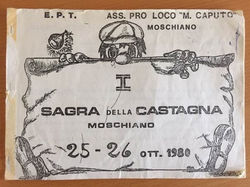
Pro Loco Michele Caputo
Moschiano (Av)


Non-political, non-profit cultural and social association
Last Updated October 27, 2024
IL MARRONE DI SANTA CRISTINA
The history of Marrone di Santa Cristina is very ancient, at least as old as the place where it originated and which gave it its name. As already reported on other pages, it is immersed in fresh and imposing chestnut groves. Chestnut groves have been present in their natural state since time immemorial and which the precious work of man, over the centuries, has improved and enhanced the production and quality of the fruit. It is believed that this variety, whose characteristics make it more similar to a chestnut than a chestnut, was selected over a century ago, chosen among those existing in the area, because it is of excellent quality and responds well to the local pedoclimatic conditions. The narrative that was handed down orally in the past, from generation to generation, also convinced the first experts who described its pomological characteristics to call it, precisely, "Marrone di Santa Cristina".
A cultivation that over time spread throughout the various mountain municipalities of the area, so much so that some gave it a second name, a synonym, brown del Vallo di Lauro, to consecrate its presence throughout the geographical area where it was present. Its consecration, as a typical and valuable Irpinian variety, took place starting from the 1970s, by the agronomists and foresters of the Agricultural Inspectorate and the Forestry Inspectorate of Avellino, who exalted its merits and characteristics in their reports. In these notes, which university researchers confirmed, it was also reported that this chestnut had nothing to envy of the most famous ones in the Irpinia province: the Castagna di Montella and the Castagna di Serino.
But the first real initiatives to valorise the Marrone di Santa Cristina were carried out by the inhabitants of Moschiano who, starting in 1980, wanted to dedicate a festival to the precious fruit that would also celebrate its economic importance for the territory. Since then, the variety has been recognized by all as being of absolute value and was included, on the proposal of the Campania Region, in the National List of Traditional Agri-Food Production (PAT) published in the Official Journal in July 2000. Finally, in 2025, the promoting committee was established for the registration of the "Marrone di Santa Cristina" denomination as a PGI which will shortly present the application for recognition to the European Union through the Ministry of Agriculture.
Description:
The fruit is medium-large in size. In fact, the average number of fruits per kg. it is between 60 and 90. The excellent size of the fruit is one of the main distinctive characteristics of the product. The shape is basically rounded, mostly asymmetrical. The apex is acute to open, with medium-wide hairiness. The pericarp (the peel) is brownish brown in colour, tending to be reddish, brightly shiny, with dark, evident streaks. It is not very elastic and mostly thin, with a tough consistency. The hilum has a mostly rectangular shape and little residual hair, a regular contour line. The torch, medium long, curved and inserted obliquely at the apex of the fruit.
The episperm (membrane) is on average adherent to the seed, thin, light reddish-brown in colour, with darker and more evident ribs, not very adherent to the seed, into which it penetrates slightly, detachable at the time of peeling or peeling (both considered valuable characteristics in a chestnut). In fact, the percentage of set fruits does not exceed 10%. The seed (the edible part) is milky white in colour, with rather superficial grooves and a barely visible intercotyledonary cavity; the pulp is firm and crunchy, not floury, with a sweet to very sweet flavour. Rare are the fruits split when harvested. The fruits of the Marrone di Santa Cristina are nutritious and digestible which meet the current needs of consumers, who are increasingly oriented towards natural and genuine foods which provide biologically active substances, fundamental for a healthy diet. Unlike most pulped fruits, the water content is relatively modest, in fact in the fresh product it is around values of 50% (maximum 60%), which drops, in dried chestnuts, to around 10%.
From physical-chemical analyzes carried out in 2024 by the Institute of Food Sciences of the CNR of Avellino, on fresh and dried chestnuts, the values found confirm that Marrone di Santa Cristina is a product of excellent quality, with high contents of macronutrients and with a good sugar content, in both commercial categories.
By the Promotion Committee for the Registration of the “Marrone di Santa Cristina” PGI name
 Marrone Santa cristina |
|---|
 Castagne |
 1980 Prima Sagra Castagna |
 1981 Sagra Castagna |
 Castagne a NY USA |
 Castagne 2 |